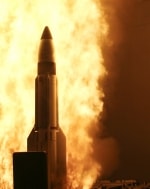
A missile fired from the American Navy cruiser USS Lake Erie has successfully disabled a malfunctioning spy satellite that was about to enter Earth’s atmosphere. Marine General James Cartwright said there was an 80-90% chance that the missiles, fired from the Pacific Ocean west of Hawaii, had hit the satellite’s fuel tank.
Officials had cited the tank’s 450 kg of hydrazine as the key reason for disabling the satellite. Had the fuel tank reached Earth, the toxic gas could have harmed individuals close by. Cartwright said that debris from the stricken satellite appeared to be too small, however, to cause damage on Earth.
The firing represented an early and serendipitous rehearsal of American anti-missile defence. The SM-3 missile used to hit the satellite is under development as part of the American Navy’s sea-based missile defence system. It is intended to provide protection against medium- and long-range ballistic missiles.
Cartwright said that the missile collided with the 2250kg satellite some 210 km above the Earth’s surface, at a combined speed of 35,000 kilometres per hour. “The technical degree of difficulty was significant here,” he said.
“It’s a brilliant public relations opportunity for the ballistic missile defence system.” Ivan Oelrich, Federation of American Scientists
However, the difficulty of hitting a satellite in low orbit hardly compares with that of striking a missile in flight. “This is easier than the ballistic missile intercept that the system was designed for,” explains Ivan Oelrich, a security specialist at the Federation of American Scientists. “The satellite is a substantially larger target — probably between the size of a minivan and a small school bus. It’s also on a very predictable trajectory. And it’s high enough to predict with high accuracy where it will be.” The US Department of Defense chose to fire from a ship because the ship could be aligned with the track of the satellite.
Missile showcase
Oelrich is among critics who see the event as less a technical test than a chance for the Bush Administration to showcase its hotly disputed missile defence system. “I don’t think the public safety argument holds up. The US produces 16 million kilograms of hydrazine per year, which we ship around in trucks,” Oelrich says. “But it’s a brilliant public relations opportunity for the ballistic missile defence system. We were told that it has saved us from a grave threat.”
Critics have also suggested that the US destroyed the satellite because it feared that its ultrasecret technology could be made public if large parts of the satellite survived the plunge through the Earth’s atmosphere. That, however, seems unlikely. Analysts suggest that such technology would automatically be adapted to burn up before reaching Earth.
More troubling is that the event appears to be a response to China’s use of a ground-based missile to destroy a satellite last year. “We should be working on a treaty to ban antisatellite weapons,” Oelrich says. “But the Bush Administration opposes it and says it couldn’t be verified.”



